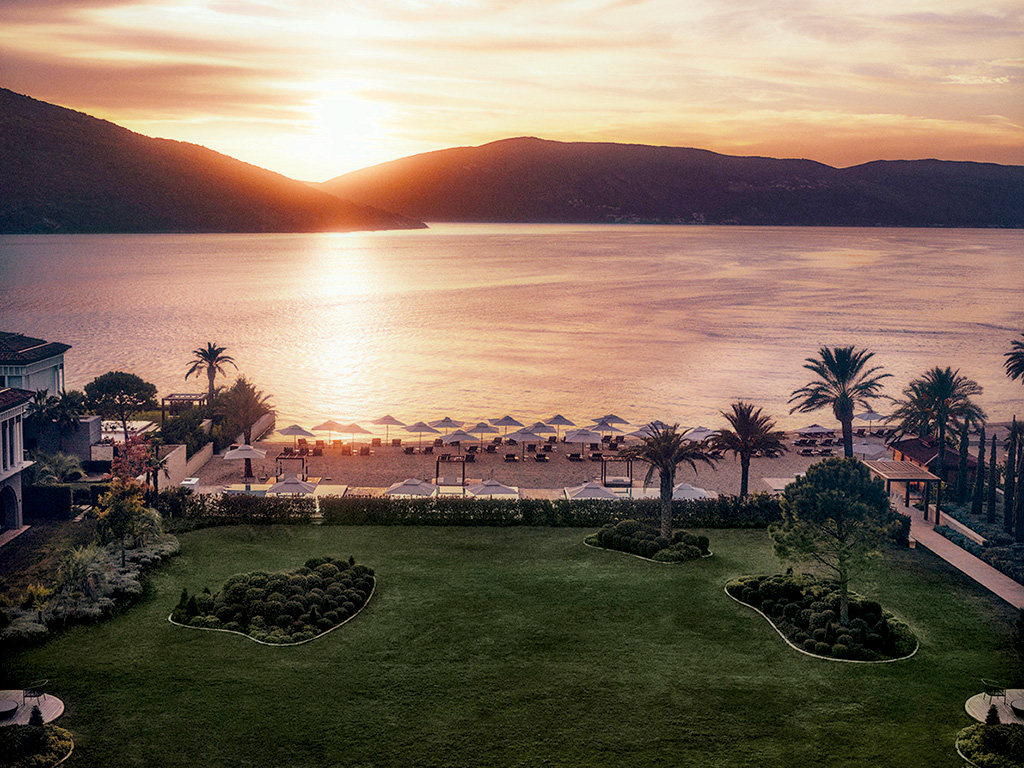
Cruising on a yacht through Montenegro’s Bay of Kotor, the southernmost fjord in the world, I have to crane my neck to see the top of the towering mountains that surround us on all sides.
As stunning as any Norwegian fjord, the luxury yachts and palm tree-lined promenades add a touch of French Riviera-style glamour, while the famous island of Our Lady of the Rocks (built by hand in the 15th century) and the area’s many other ancient monasteries and terracotta-roofed medieval towns complete the idyllic scene perfectly. Despite being a small European country (covering 13,812 km²), the diverse and fascinating landscape of Montenegro boasts many claims to fame. Home to the deepest canyon in Europe (the Tara River Canyon), the largest lake in the Balkans (Lake Skadar), the biggest vineyard in Europe in a single complex, and one of the largest Orthodox shrines in the world, it also offers 300km of rugged coastline, and endless attractions for visitors interested in nature, outdoor activities, culture and history. CULTURE AND NATURE COMBINED Offering a tempting mix of wild and untouched nature and Mediterranean-inspired glamour, Montenegro invites you to spend your days dining on sun-kissed waterside patios, hiking through mountains, gorges and lush national parks, and discovering over 100 mesmerising beaches, including Amalfi Coast-like hidden coves, and the 13km Velika Plaža (meaning Long Beach in English). Once part of the former Yugoslavia and home to a population of 620,000, it offers around 240 days of sunshine per year and a pleasant average summer temperature of 27°C. Allowing visitors to experience a vast array of diverse activities without having to travel too far, many of its finest cultural attractions are around the walled medieval city of Kotor (a UNESCO World Heritage Site since 1979) and Cetinje, the historical and cultural capital. Summer is also the perfect time to discover the country’s famous festival scene. Home to some of the biggest festivals in Europe, The Kotor Art Festival takes over the picturesque town every July and August, while the Montenegro Film Festival has been hosted every summer for the past three decades.Luxurious and unique resorts
Tourism in Montenegro has two different sides.
While ‘authentic’ and 'rustic' Montenegro can be experienced by enjoying locally inspired dinners served inside the medieval St. Nicholas Franciscan Monastery (arranged through local agency TravelTwitch), and touring the centuries-old Moric Olive Farm, the luxury travel industry is also well represented through the country's vast collection of prestigious hotel groups, renowned restaurants and glamorous ports and beach clubs.
For instance, while Boka is renowned as Montenegro’s party town and the centre of tourism, The One&Only Portonovi, at the entrance to Boka Bay, is the very definition of elegance and sophistication.
A sprawling 60-acre resort home to 105 guest rooms, six suites, two villas,10 One&Only Private Homes, the delightful facilities include a private beach, private jetty, and a Chenot Espace Spa, while helicopter transfers can also be arranged upon request.
Nestled amongst the super yachts and luxury boutiques of Porto Montenegro marina, the Regent Porto Montenegro is another prime accommodation choice. Spanning three different wings comprising 175 rooms, suites, and penthouses, the surrounding area boasts more than 70 high-end bars, restaurants, and shops. Sunset Hospitality Group is bringing AURA Beach, the sister beach club of Dubai’s AURA Skypool, and Latin American restaurant and bar D’LIRIO to the port this July, and introducing two further outlets - Attiko and Folie beach club - next year as well.
Just a ten-minute drive from Tivat airport, GCC guests can fly to Tivat with Turkish Airlines during the summer months (via Istanbul), and to the capital Podgorica throughout the rest of the year.
World-class developments
Another exciting place to stay is the 690-hectare Luštica Bay development.
Once complete, it will feature seven luxury hotels, 3,000 apartments, over 300 sea-view villas, seven beaches, two world-class marinas with 220 berths, and - perhaps most exciting of all - Montenegro’s first 18-hole championship golf course, designed by golfing legend Gary Player and expected to be completed by 2028.
The five-star Chedi Luštica Bay has also been open since 2018. Offering 100 spacious rooms, 10 suites, and a luxurious penthouse, its facilities include a private beach, outdoor pool overlooking the Adriatic, an Asian-inspired spa, and Adriatic, Asian, and vegan cuisine across four restaurants and bars. Focused on eco-conscious living, it is the first hotel in Montenegro (and one of the first 100 hotels in the world) to be awarded Forbes Travel Guide’s Responsible Hospitality VERIFIED badge.
